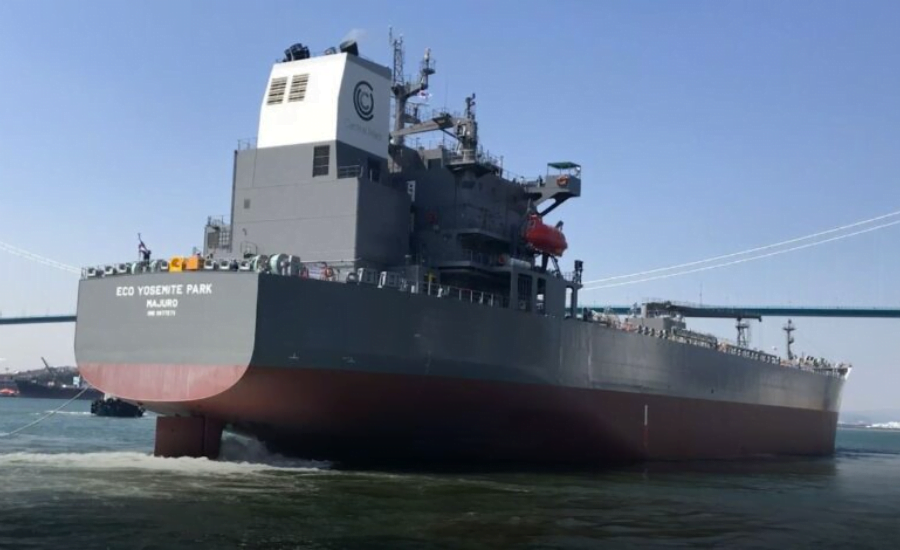
What is a wall wash test (wwt)? Everyone who is not a chemical tanker might ask this question. You may have come across this word at least once during an exam or at the beach, but you still don’t quite understand it. Don’t worry; whether you are a beginner or want to ride a chemical tanker for the first time, this article will help you. Wall Washing Tests (wwt) are taken out on chemical tankers after tank cleaning operations have been completed on their cargo tanks.
A Wall Wash Test (wwt) is required to determine the cleanliness of the container. That is, whether the ship is ready to load its next cargo, whether it needs further cleaning, etc. The Wall Wash Test (wwt) requires ship personnel to enter a cargo tank and also collect samples at various locations. Equipment called a spectrometer (U.V. test equipment) is usually provided on board by the ship’s charterer or owner to carry out wall washing tests (wwt).
The Spectrometer
The spectrometer provides result data such as hydrocarbons (H.C.), chloride (Cl), permanganate time test (PTT), APHA color, and U.V. scan charts. These play an important role in determining whether the tank is suitable for the next load. Whether it is suitable for cargo. Ship personnel should be familiar with the use of shipboard spectrometers to carry out wall washing tests (wwt) on board and ensure compliance with the required cleanliness standards.
Wall Wash Test (wwt) result data and U.V. scan graphics may be requested by charterers at any time. As soon as the ship arrives at the loading port, a cargo inspector will board the ship to take paint samples from the walls. Samples taken by experts will be tested in an onshore laboratory. Loading of the cargo will begin only after the samples taken by the assessor pass. To better understand the Wall Wash Test (wwt), we will discuss the following:
- Cleanliness Standards for Chemical Tanker Cargo Tanks Tank Cleaning
- 2 Items/Equipment Required for Wall Washing Test (wwt)
- 3 Methods and also Types of Wall Washing Test (wwt)
- 4 Wall Washing Test (wwt) and Analysis of wash water
Cleanliness Standards for Cargo Tanks on Chemical Tankers Tank Cleaning
Cleanliness Standards for Cargo Tanks on Chemical Tankers are being present in the INTERTANKO publication. These standards are designed to simplify the tank cleanliness verification process and reduce a need for in-tank inspections. The primary purpose of these an cleanliness standards is to provide predictability regarding the cost and also time required to clean tanks. Additionally, it aims to avoid excessive tank cleaning, improve port circulation, clarify charter conditions, and reduce the number of tank inspections in ports.
Cargo tank cleanliness standards fall into four standards.
- Visually Clean Standard
- Water White Standard
- High Purity Standard
- Ultra High Purity Standard
Visually Clean Standard
In the visually clean standard, tanks are inspected from . Deck level and no wall wash test (wwt) required. Tanks must be clean, dry, and also free of visible residue or foreign material from previous cargo. There should be no peculiar odor.
Water White Standard
The Water White Standard inspects the interior of the tank and also performs a wall wash test (wwt). Tanks must be odor-free, clean, dry, and also visibly free of previous cargo residue or foreign material. In Water White Standard Wall Wash, color testing is performed using methanol, acetone, or also other suitable solvent. An acceptable result for this color test is 15 or less.
High Purity Standard
High purity standards are often used to transport methanol cargoes. This standard is often referred to as the methanol standard. For high purity standards, the interior of the tank is also inspected, and a wall wash test (wwt) is performed using methanol, acetone, or other suitable solvents. The standard also requires that tanks be clean, dry, odor-free, and visibly free of previous cargo residue or foreign matter. Acceptable result values are listed below:
- Water miscibility/hydrocarbon test must pass
- Color <10> 50 minutes
- Chloride must be less than two ppm
- U.V. spectrum passes
- Wash water must pass the following tests to ensure less than 100 ppm of the last load.
Ultra High Purity
Ultra High Purity specifications require a more stringent level of purity than High Purity specifications. It is used to transport very demanding loads. The ultra-high purity standard also inspects the interior of the tank and performs a wall wash test (wwt) using methanol, acetone, or other suitable solvent. The standard also requires that tanks be clean, dry, odor-free, and visibly free of previous cargo residue or foreign matter. Acceptable result values are:
- Must pass water miscibility/hydrocarbon test
- Color <10> 50 minutes
- Chloride must be less than two ppm
- NVM (non-volatile substances) <; 10 ppm
- Final load < 2PPM using gas chromatography or other suitable method
- U.V. spectrum passes
- Test of Wash water is a must to ensure no more than 100PPM of final load
Items/Equipment Required for Wall Wash Test (wwt)
- Spectrometer
- Laboratory-grade methanol, acetone, and also other suitable solvents
- Laboratory-grade deionized water (D.I. water)
- PTT ( Potassium Permanganate Powder (0.1 g) for Permanganic Acid (Test)
- Hydrochloric Acid Solution
- Sulfuric Acid – Laboratory Grade
- Nitric Acid
- Silver Nitrate
- Acidic Silver Nitrate Solution (Optional)
- Chloride Standard Solution 10 PPM/500 ml
- Disposable latex gloves
- Measuring meter graduated glass cylinder, calibrated for 50 ml and 100 ml, with stopper and also base – Nessler tube.
Wall Wash Test (wwt) Procedures and Types
Wall Wash “Do’s” and “Don’ts”
- Use a bucket or backpack to carry wall-cleaning solvent spray/squeeze bottles and funnels. , and also labeled sample bottles for each tank.
- Wear disposable latex gloves, shoe covers, clean or disposable coveralls, and also personal protective equipment (PPE).
- Before collecting wall wash samples, ensure the rinsing of all items in the bucket with methanol after entering each tank. This ensures cleanliness and also avoids cross-contamination. Randomly select a location on each partition for the wall cleaning sample. Align the funnel and also sample bottle with one hand. Spray the bottle at least 1 meter above the funnel and collect the wall wash sample into the sample bottle. Collect approximately 50 ml of wall cleaner from each partition, enough for testing purposes.
- Follow company entry procedures when entering the tank.
- Do not take samples from wet bulkheads.
- Always prepare fresh standard solutions for testing and clean all sample tubes and pipettes before use.
- Always handle samples with appropriate care to avoid contamination of the sample with human sweat and also to ensure absolute cleanliness.
Wall Wash Test (wwt) Types
Hydrocarbon (H.C.)/Water Miscibility Test
1 To prepare a standard or reference solution: 10 mL of laboratory-grade methanol and 10 mL of laboratory-grade deionized water (D.I. Water) to laboratory-grade deionized water (D.I. Water). Sample/Nessler – Tube. To prepare the test solution: Add 10 mL of the tank sample and 90 mL of laboratory grade deionized water (D.I. Water) to the sample/nettle tube. Note: Adding methanol to deionized water makes the hydrocarbon test more stringent. The dilution rate varies depending on the company and loading port. Other commonly used ratios are (25: 75, 33: 67, and 50: 50).
Water and methanol.Next, leave the sample/Nessler tube upright for 20 minutes. Place the tube on a black surface and turn off the light. Shine a flashlight on the side of the tube and look through the column of liquid. If a bluish tint is visible, this indicates the presence of light hydrocarbons. Observation of whitish turbidity usually indicates the presence of medium to heavy hydrocarbons. If the sample is clear, it means no hydrocarbons are present. To test for specific hydrocarbons and chemicals, both the reference and also test samples can be bring out to the spectrometer’s UV light source.










